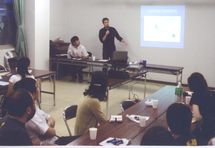| September, 2006 Issue(No3) | |
| September, 2006 Issue(No3) | |
 |
||
| Thursday, July 6, 2006 | ||
 By inviting Mr. Kieran O'Connell, who came from New Zealand a year ago,
we learned about its history, culture, sightseeing spots, and so on at
the Community Center Haruta Nishi. The following is his story. By inviting Mr. Kieran O'Connell, who came from New Zealand a year ago,
we learned about its history, culture, sightseeing spots, and so on at
the Community Center Haruta Nishi. The following is his story.In New Zealand, it is common for people in their 20s to go and live overseas for one or two years. Some people, however, don't return. Take my family for example, my oldest brother has lived in Sydney, Australia for  more than seven years. My second oldest brother lived in Japan for four years and moved to Dubai in the UAE six months ago. Another brother has stayed in Taiwan for more than five years. I myself have lived in Japan for a year. Like this, in New Zealand it is expected that people will go abroad. It is true to my case, too. When I said to my boss that I would like to go abroad, he said that he was waiting for me to say that. As most people eventually return to New Zealand, they are considered to bring back broad experiences and knowledge. more than seven years. My second oldest brother lived in Japan for four years and moved to Dubai in the UAE six months ago. Another brother has stayed in Taiwan for more than five years. I myself have lived in Japan for a year. Like this, in New Zealand it is expected that people will go abroad. It is true to my case, too. When I said to my boss that I would like to go abroad, he said that he was waiting for me to say that. As most people eventually return to New Zealand, they are considered to bring back broad experiences and knowledge.Now, about the land. As you know, New Zealand consists of the main two islands and other small islands. It's quite similar to Japan. Geographically speaking, both are island countries, almost the same size―Japan is a little bigger, though― and have similar landscapes. We also have similar looking mountains. Because Mt. Taranaki looks like Mt. Fuji, it was used in the movie The Last Samurai as a backdrop.  Perhaps the biggest difference is the number of people. Japan has 124 million,
and New Zealand 4 million. The capital city, Wellington, has about the
same number of people as Otsu. I was surprised to see so many people in
Shibuya. The average temperature in summer is between 20 and 30 degrees
Celsius, and in winter between 10 and 15 degrees Celsius. The further south
you go, the colder it gets. Perhaps the biggest difference is the number of people. Japan has 124 million,
and New Zealand 4 million. The capital city, Wellington, has about the
same number of people as Otsu. I was surprised to see so many people in
Shibuya. The average temperature in summer is between 20 and 30 degrees
Celsius, and in winter between 10 and 15 degrees Celsius. The further south
you go, the colder it gets.New Zealand has a relatively young but interesting history. The Maori began to live in New Zealand about 1200 or 1300 AD. They lived by catching birds and fish and making tools for gardening. In 1642, the Dutch explorer, A  bel Tasman, discovered this land and later Captain Cook. After that, sealers,
whalers, traders and the like came in, whose influence on the Maori was
not too good. Once gold was discovered in the 1870s, more and more people
migrated to the country, and conflicts broke out frequently between the
Maori tribe and the European settlers, which lasted until the 1880s. bel Tasman, discovered this land and later Captain Cook. After that, sealers,
whalers, traders and the like came in, whose influence on the Maori was
not too good. Once gold was discovered in the 1870s, more and more people
migrated to the country, and conflicts broke out frequently between the
Maori tribe and the European settlers, which lasted until the 1880s. New Zealand is a wonderful country to visit, because prices are relatively cheap, the scenery is spectacular, and people are friendly. The South Island, where I grew up is especially recommended. Christchurch, known as a garden city, has its population of 300,000, and you can fly there directly from Japan. Two hours away from Christchurch is Lake Tekapo, and near the lake is Mt. Cook. Very close to the mountain is Tasman Glacier, on which you can walk if you are brave. The beauty of Milford Sound that has remained intact is wonderful. In the 19th century, only a handful Japanese people migrated to New Zealand and now more than 10000 Japanese nationals live in New Zealand. Mr. O'Connell talked more about the attractiveness of the country than that written in this page. The audience had so many questions both in English and Japanese one after another that they seemed to forget time was passing. Lastly, Mr, O'Connell asked the audience, who wants to go to New Zealand. Then everyone cheerfully raised a hand, saying, "Haaaai" in chorus. It was a very enjoyable time. Last but not least, the interpreter was a RIFA member, Mr. Sato. |
||
| −We are waiting for your contribution.− | ||
|
We are waiting for your manuscripts; an essay, a travelogue, a poem, a
tanka(Japanese traditional poem consisting of 5-7- 5 -7-7 syllables), a
haiku(Japanese traditional poem consisting of 5-7-5 syllables) and anything
you like. We will present a small gift for the adopted contributor. Please send your manuscript to RIFA with your postal code, address, name, phone number, and fax number. |
||
|
September, 2006 Issue(No3) |